Organography and Plant Histology of Aloe vera (Liliaceae)
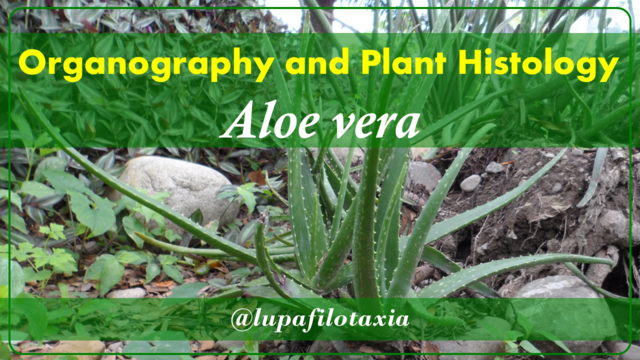
In this publication, besides socializing botanical elements of organographic and pharmacological character, I will present results of histological cuts made to vegetative segments of the Aloe vera (Liliaceae) species.
Introduction
The Aloe (Aloe vera), is a plant species of herbaceous biotype and perennial, widely used for its homeopathic and allopathic effects, in addition to its extraordinary pharmacological and cosmetological properties, which is why it is considered the most important phytonatural resource among plants, this due to the presence of more than 200 secondary metabolites considered beneficial to health [1].
Aloe vera, in addition to the properties described above, has the phenological advantage of growing and developing in xerophytic ecosystems with low water availability, due to its morphological characteristics that give it the capacity to store considerable volumes of water in its leaf structures.
In the post, we will detail in detail the histological organographic characteristics, as well as the pharmacological and cosmetological properties of Aloe.
Biological classification
Kingdom: Plantae
Division: Magnoliophyta
Class: Liliopsida
Order: Liliales
Family: Liliaceae
Genus: Aloe
Species: vera
Common names
This prodigious vegetable species is usually called from the vernacular point of view by its same scientific name Aloe vera, however, in Spain it is designated as Zabila, in the United States as Barbados, in Brazil as Curacao, while in the rest of South America it is called Sábila.
Pharmacological properties
The multiple phytochemical compounds of Aloe vera, position this important plant resource, with the highest number of pharmacological properties used from the therapeutic point of view, among these:
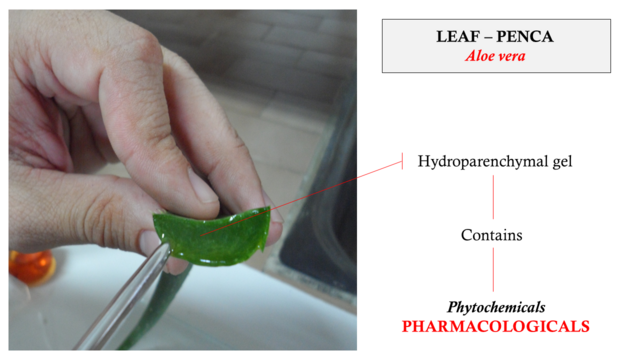
Fig. 2 On the left we can see Aloe vera leaf (penca), secreting phytochemical substances, on the right side description around the Aloe hydroparenchymatic gel. Author: @lupafilotaxia.
A. Anti-inflammatory activity: Preparations based on Aloe vera leaf gel produce anti-inflammatory effects, due to their capacity to inhibit the enzyme Cyclooxygenase, a phytobiological action that leads to a reduction in the production of Prostaglandin (a phytochemical substance that stimulates inflammation and pain), triggering a response that reduces inflammatory suffering.
B. Healing effect on the skin: It has been reported the healing effect of Aloe vera gel, on wounds and burns on the skin, this for its natural action in the restructuring of collagen.
C. Anti-tumor action: Aloe vera contains phytochemical substances that act on cellular disorders responsible for the appearance of tumors. It is known that the glycoproteins present in aloe vera gel act on cell division, producing morphologically normal cells that benefit anti-tumor activity.
D. Antidiabetic response: Aloe vera leaf extracts have antidiabetic effects because the biomolecules present in the parenchymal tissue regulate the carbohydrates in the blood.
E. Antibacterial action: Aloe has properties of antibiotic nature, which is why, from the ancestral point of view, leaf extracts are prepared to treat conditions related to bacterial activity.
F. Other properties: Other pharmacological effects have been reported in Aloe vera among these can be mentioned; its moisturizing, antiseptic, detoxifying, laxative function, in addition to its broad cosmetological potential.
Origin and distribution
Aloe vera is native to North Africa and, according to [2], has a cosmopolitan distribution, which reflects that it is a plant with extensive geographical representation and zoning.
Gender Aloe in Venezuela
The genus Aloe has around 100 species in Venezuela, according to the [3], being Aloe vera the most biologically rich and widely distributed in the central western region of the country.
Botanical description
Way of life
Aloe has a perennial biotype which indicates that its flowering phase usually runs more than twice throughout its biological period.
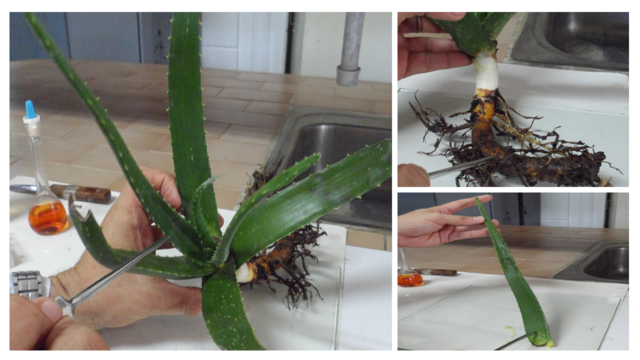
Fig. 3, 4 and 5 On the left Aloe vera seedling, upper right side, rhizomatous root and stem, lower side Aloe vera succulent leaf (penca). Author: @lupafilotaxia.
Root
It has long main root with rhizomatous morphology and widely developed lateral roots.
Stem
It has a rhizome type stem of herbaceous consistency.
Leaves
It presents thick and succulent foliar laminae, with absence of petiole, of triangular morphology, widened base, acute apex, serrated margins with aspect of thorns and alternate spiral phyllotaxy.
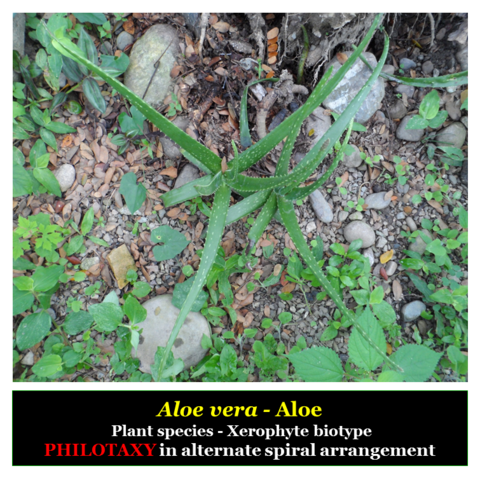
Fig. 6 Alternate Aloe Vera spiral phyllotaxy arrangement. Author: @lupafilotaxia.
Inflorescence
Exhibits cluster-like inflorescence approximately 1.5 meters high.
Flower
The flowers of Aloe vera, are presented phyllotaxically in helical condition (disposition in helix), the floral units exhibit tepals of yellow color, whereas the reproductive bud is located in apical direction.
Fruit
The fruit of Aloe vera, has a capsule morphology of dry consistency, originating from a super tricarpellar and sincere ovary.
Seeds
It has small seeds with winged morphology.
Reproduction
Sexual reproduction
Like the rest of the species of the genus Aloe, the Aloe reproduces by means of its floral structures, through the consequent union of the male gametes of the androceous and gynoecium.
Asexual reproduction
Aloe has meristematic structures at the base of the rhizomatous stem, which emits offspring (new seedlings) through vegetative propagation.
Growth
The growth habit of Aloe vera, is mainly slow fulfilling its phenological cycle in a period of approximately 3 years, however, it usually reaches its average height of 55 cm in the first 6 months of life.
Life cycle
Aloe vera, is a Liliopsida type vivacious which indicates that it is a perennial plant species with the ability to flower and produce seeds more than once in their life cycle.
Ecology
CAM mechanism in Aloe vera
Aloe belongs to the group of Crasulaceae plants, so it has a mechanism type CAM (Mechanism Acid Crassulaceae) by its acronym in English, this means that Aloe vera presents photosynthetic ecology typical of desert environments or xerophytic, however, presents adaptability to various tropical and subtropical humid ecosystems.
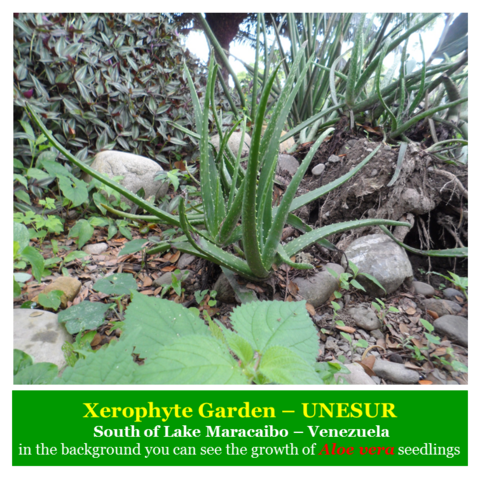
Fig. 7 Aloe vera seedlings, growing in the area of the UNESUR Xerophytic Garden. Author: @lupafilotaxia.
Histology and organography
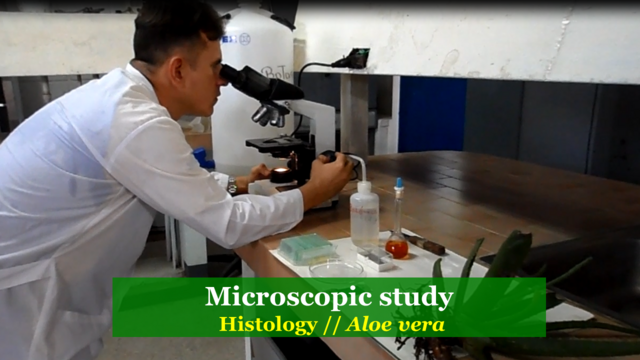
Fig. 8 Morphohistological study - Aloe vera. Author: @lupafilotaxia.
Microscopic study
In order to extend the existing information, a histological study on the vegetative structures of Aloe vera was developed, using the optical microscope for the morphological characterization at the tissue level.
Collection
The vegetative material of Aloe vera, was collected from the Xerophytic area of the Botanical Garden of UNESUR, located in the municipality of Colon in the state of Zulia - Venezuela.
Histological identification
The vegetative structures of Aloe vera were placed in containers with water to guarantee the turgidity of the tissues, later they were transferred to the laboratory facilities of UNESUR Botany.
Materials and reagents used
- Plants of Aloe vera (Sábila)
- Carrier sheets and coverslips
- Botanical dissection team
- Petri dishes
- Optical microscope
- Distilled water
- Lugol
- Safranin
- Floroglucin
Tissue Observation
The histological structures of Aloe vera were observed using OPTIKA microscopes, for the identification of epidermal tissue, trichomes, parenchyma, photosynthetic and reserve, cross sections, longitudinal and tangential to the leaves (pencas), first proceeded to focus to 4x to locate tissue and then changed to 10x, for morphological characterization.
As for the observation of the xylem and phloem conduction tissues, cross sections were made to adventitious Aloe vera roots.
Histological results
Epidermal characterization
The adaxial and abaxial epidermis of Aloe vera presents a thick and smooth cuticle on the external face with an absence of trichomes, the cells present an asymmetric morphology, while the stomas observed are tetrachytic (four cells annexed by the stomach apparatus) and amphistomatic type clearly appreciable both in the beam and the back, under the epidermal tissue clusters of chlorenchymatic cells of circular morphology were observed.
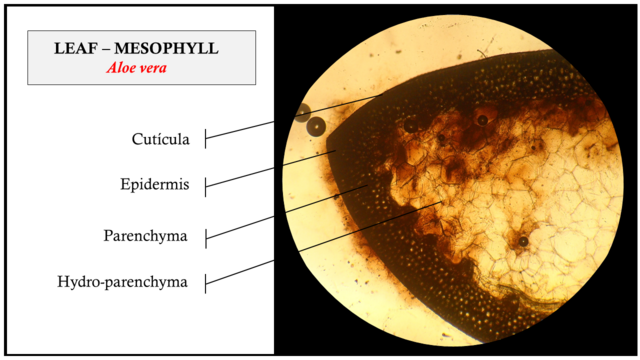
Fig. 9 On the right side, there is a detailed cross section of the Aloe vera leaf (penca), on the left side, the location of the cutinized and smooth epidermis is indicated, followed by the chloroenzyme and hydroparenchyme tissue. Author: @lupafilotaxia.
Parenchymal characterization
The mesophyll of the Aloe vera leaves presented a reserving parenchyma or hydroparenchyma of homogeneous aspect and lobed to rectangular morphology, with large vacuoles and in whose cellular interior opalescent and viscous substances could be appreciated.
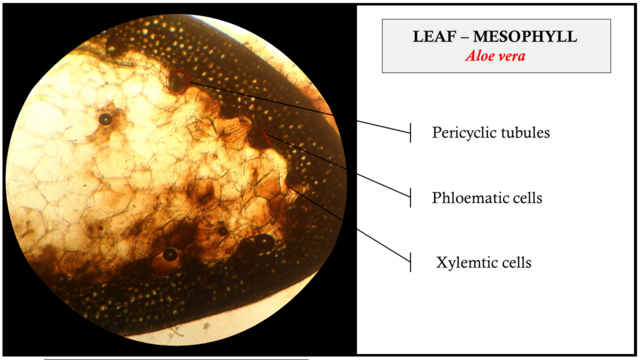
Fig. 10 On the left side, there are pericyclic tubules in Aloe vera leaves, on the right side it is indicated, the location of the xilematic and phloematic cells. Author: @lupafilotaxia.
Xylematic and phloematic characterization
The cross section of the Aloe vera leaf showed, between the chlorenchymal tissue and the parenchymal reserve cells, compact vascular bundles constituted by xylem and phloem cells, with appreciable interconnections in the form of pericyclic tubules filled with yellow gelatinous substances. In relation to the transversal section of the adventitious root of Aloe vera, vascular bundles could be observed in an orderly and circumferential disposition around the medulla.
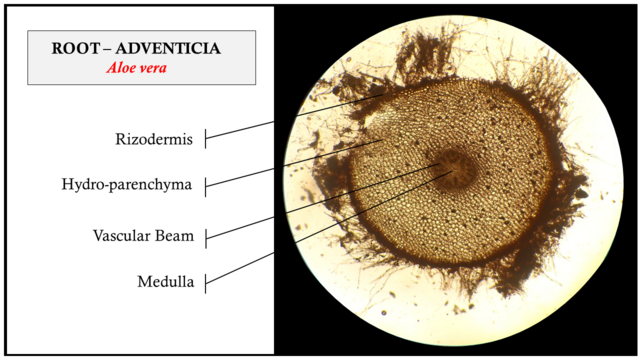
Fig. 11 On the right side, a cross section of the adventitious root of Aloe vera is detailed, on the left side, the location of the rhizodermis is indicated, followed by the idroparenchyma, vascular bundles and medulla. Author: @lupafilotaxia.
SCIENTIFIC CONTRIBUTIONS OF THIS PUBLICATION
- In the organographic, morpho-anatomical and histological description of the Aloe vera, together with the scheme on the pharmacological elements, unpublished contributions to the areas of plant morphology and utilitarian botany stand out, as a scientific expression for the recognition of the main characteristics of this important plant material. On the other hand, the schematic structure and form of presentation of contents implicit in the publication, increases the botanical resources for its specialization in multimedia formats.
BIBLIOGRAPHICAL REFERENCES CONSULTED AND CITED:
[1] Yagi A., Machii K., Nishimura H. Effect of aloe lectin on deoxyribonucleic acid synthesis in baby hamster kidney cells. Experientia. 1985;41:669-671. Article: Online access
[2] Cronquist A. The Evolution and Classification of Flowering Plants. The New York Botanical Garden. New York. 1988. Book: Direction of digitization
[3] Badillo V., Schnee L., y Benítez C. Clave de las familias de plantas superiores de Venezuela. Espasande Editores. Caracas. 1985. Book: Download address
[4] Ahmada M., Khana Z., Mukhtara A., Zafara M., Sultanaa S., Jahanb S. Ethnopharmacological survey on medicinal plants used in herbal drinks among the traditional communities of Pakistan. Journal of Ethnopharmacology. 2016;184;26:154–186. Article: Online access
[5] Gajendra M., and Sharique A. Recent update on the medicinal properties and use of Aloe vera in the treatment of various ailments. Pharmaceutical Communication. Biosci. Biotech. Res. Comm. 2016;9;2:273-288. Article: Online access
ATTENTION / Readers and Followers
If you want to read more scientific articles of excellent academic quality, do not waste time, and visit the label #steemSTEM, is a large community that values and promotes scientific content, mainly in the areas of Science, Technology, Engineering and Mathematics.

INVITATION
Dear reader, if you wish to obtain more information about it, join our server in Discord
OBSERVATIONS
✔ The POST 📧📨 was uploaded using the official app of https://www.steemstem.io
OBSERVATIONS
✔ The POST 📧📨 was uploaded using the official app of https://www.steemstem.io
You can visit the official app of our community
https://www.steemstem.io
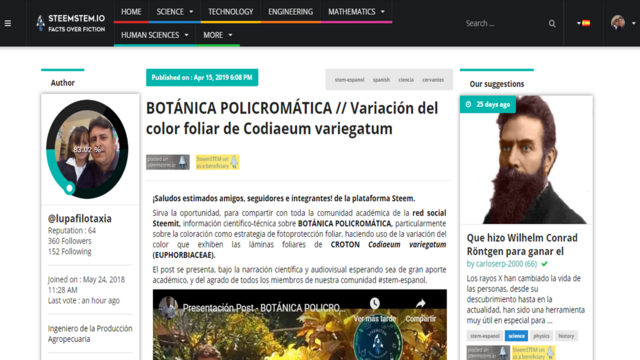

You can give ME LIKE or share this post on Twitter: https://twitter.com/lupafilotaxia/status/1220849285551575041
This post has been voted on by the SteemSTEM curation team and voting trail. It is elligible for support from @curie and @minnowbooster.
If you appreciate the work we are doing, then consider supporting our witness @stem.witness. Additional witness support to the curie witness would be appreciated as well.
For additional information please join us on the SteemSTEM discord and to get to know the rest of the community!
Thanks for having used the steemstem.io app and included @steemstem in the list of beneficiaries of this post. This granted you a stronger support from SteemSTEM.
To listen to the audio version of this article click on the play image.

Brought to you by @tts. If you find it useful please consider upvoting this reply.